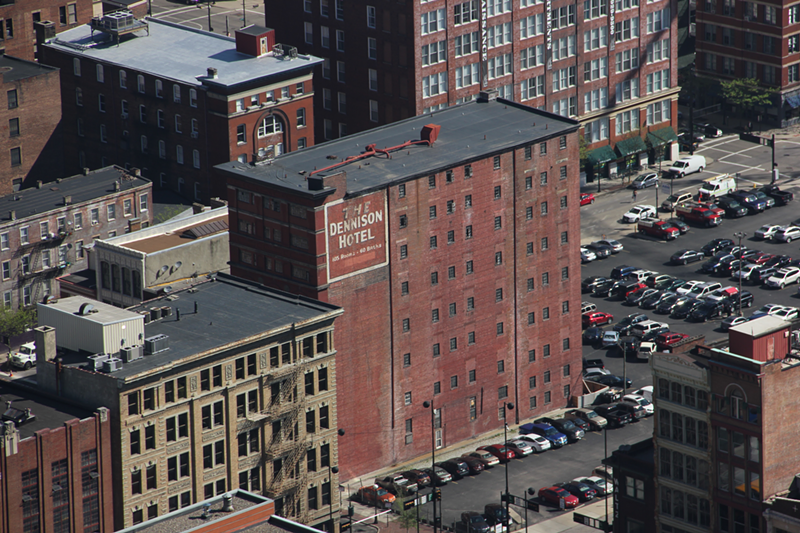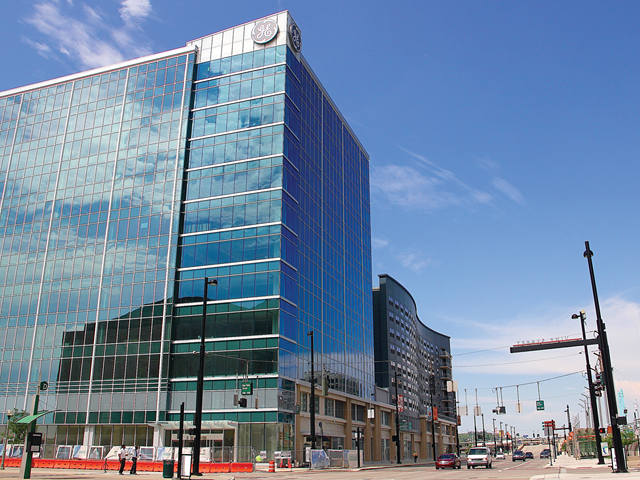Cincinnati’s Historic Conservation Board today denied an application to demolish the Dennison Hotel building at 716 Main St. by owners Columbia, REI, citing the company’s failure to prove it was an economic hardship to redevelop the building in one of downtown’s historic districts.
The battle over the Dennison has come to represent how the city will navigate tensions between downtown growth and preserving Cincinnati's historic urban fabric. Today's hearing represented preservationists’ turn to argue against the building’s demolition following a previous four-hour hearing May 26 during which lawyers Francis Barrett and Tim Burke presented Columbia and owners the Joseph family’s case.
Columbia is expected to appeal the decision to the city's Board of Zoning Appeals, setting up what could be a lengthy battle over the building's fate.
The Josephs, an influential Cincinnati family that runs a number of car dealerships in the region, say it’s too expensive to rehabilitate the building. The group’s critics say that’s not the case — an assertion echoed by the city’s urban conservator, Beth Johnson. Preservationists argue that Columbia bought the building with plans to demolish it, a move that is against historic preservation rules. The Josephs say they bought the building to protect the value of other investments they have in the area, namely a number of parking lots surrounding the Dennison. In past filings around the application, the Josephs have indicated they were motivated to purchase the property to prevent it from becoming affordable housing.
Columbia opponents also argue other developers could rehab the building. Paul Muller of the Cincinnati Preservation Association said at today’s hearing that the preservation association has eight letters from interested developers. But the Dennison’s owners say the building isn’t for sale and that they’d like to tear it down in order to prepare a site for an as-yet-unidentified Fortune 500 company. Because the Dennison, which was built in 1892 by the firm of noted architect Samuel Hannaford, sits within the Cincinnati East Manufacturing and Warehouse District, one of 29 historic districts in the city, special permission is needed to demolish it.
Plenty of barbs flew back and forth during the three-and-a-half-hour hearing leading up to the decision. Attorney Sean Suder, who represents preservationists looking to save the building, dueled attorneys Burke and Barrett, who represent Columbia and its owners the Joseph family, on a number of points, including the relevancy and availability of state and federal historic preservation tax credits, the building’s historic significance, its present condition, whether rehabilitation costs cited by Columbia were accurate and more.
A number of witnesses testified on behalf of the building’s historic significance and the economic feasibility of saving it.
Kathleen Norris, a Cincinnati real estate consultant, reviewed a report commissioned by the Josephs that purported to show there was no economically advantageous way to rehabilitate the building. That report showed daunting costs for converting the Dennison into office space, a luxury hotel, condominiums or apartments.
Norris took issue with that last conclusion, saying that a “tremendous shortage of market rate apartments in the Central Business District” and the coming streetcar, which has a stop just a few blocks from the building, would make it very attractive to renters and allow rents as high as $2.80 per square foot. That’s similar to market rates for apartments at riverfront development The Banks.
“The fact that the Dennison isn’t The Banks is an asset, not a detriment,” Harris said, heading off rebuttal about the difference between the mid-downtown location and the riverfront. Harris said some renters would want a less-active location than the commercial and entertainment destination. She also cited the building’s historic architecture and surroundings.
“We have proven that these buildings are important, drive economic growth and we've brought them back," she said.
John Blatchford, of Over-the-Rhine-based Kunst, which does tax credit consultancy, said he reviewed data about the building’s tax credit eligibility and said it was “possible and highly likely,” that a project to rehabilitate the Dennison could net as much as $1.4 million in federal and $900,000 in state historic tax credits.
Barrett and Burke pugnaciously cross-examined most of the preservationists’ experts.
That tense atmosphere spilled over into the public comment segment of the hearing, during which both Burke and Barrett cross examined citizens speaking in support of efforts to preserve the building.
“I don’t think I need a geography lesson,” Over-the-Rhine Community Council President Martha Good snapped at the attorneys when they questioned her about why OTRCC was interested in a downtown building. Good argued that a demolition permit for the Dennison would set a precedent that could endanger other historic buildings around Cincinnati. OTRCC voted unanimously to oppose the demolition permit.
More than a dozen people spoke against Columbia’s demolition application, and about five spoke in support of the move to tear the building down. Among supporters of demolition during public comment was Lance Brown, who works for Fairfield-based Beck Consulting, which issued Columbia’s original study the company says shows rehab is unfeasible.
Ultimately, the board sided with preservationists, voting 3-2 to deny the demolition application. The board cited the fact that Columbia hadn’t proved it bought the building with intentions of trying to save it, that a rehabilitation project could be economically feasible and that the group didn’t consider possibilities like historic tax credits. Board members Shree Kulkarni, a prominent developer, and Timothy Voss voted in favor of allowing demolition.






